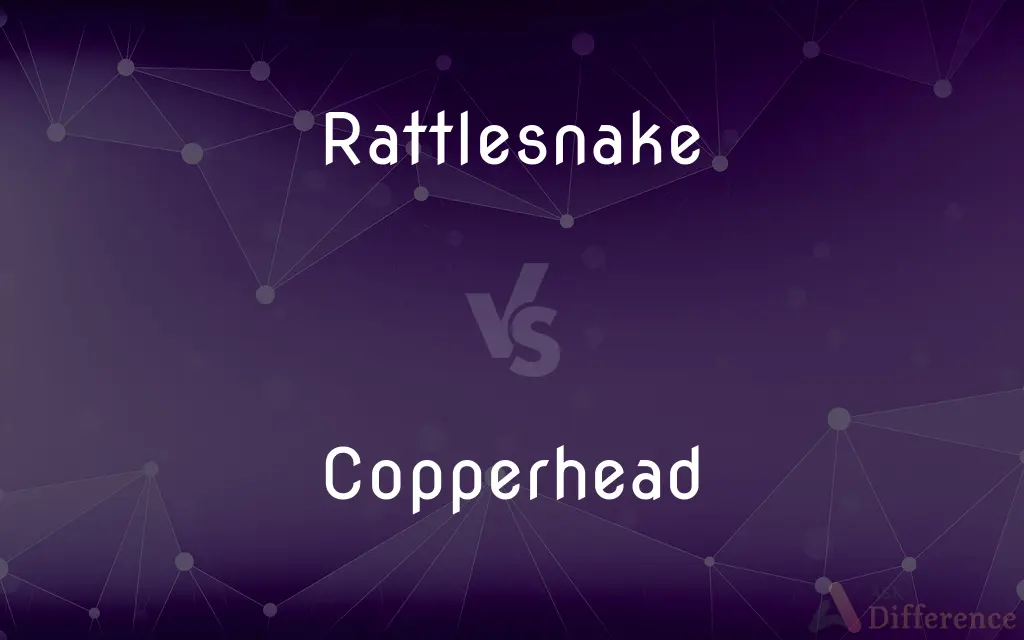Rattlesnake vs. Copperhead — What's the Difference?
Edited by Tayyaba Rehman — By Fiza Rafique — Updated on November 1, 2023
Rattlesnakes have rattles on their tails and are more widespread, while copperheads have copper-colored heads and lack rattles.

Difference Between Rattlesnake and Copperhead
Table of Contents
ADVERTISEMENT
Key Differences
Rattlesnakes are known for their distinctive rattle at the end of their tails, used to warn predators. They belong to the genus Crotalus and are found across the Americas. Copperheads, lacking this rattle, have a copper-red head and are part of the genus Agkistrodon, with a more limited range in the southeastern United States.
Rattlesnakes possess a more potent venom compared to copperheads. Their bites are serious but rarely fatal with timely medical treatment. Copperhead venom is less toxic, and their bites, while painful, are less likely to be fatal. Both species, however, are pit vipers, equipped with heat-sensing pits to detect prey.
Habitats of rattlesnakes vary from deserts to forests, and they are often more aggressive when threatened. Copperheads, meanwhile, prefer wooded areas, rocky environments, and sometimes suburban regions. They are more likely to freeze and rely on camouflage rather than attack when threatened.
In terms of behavior, rattlesnakes tend to be more solitary and active at dusk or night. Copperheads are often found basking during the daytime and can be more social, sometimes sharing dens with other snakes, including rattlesnakes.
While both snakes hibernate in colder weather, rattlesnakes often migrate to communal dens known as hibernacula. Copperheads do hibernate but may not travel as far to communal dens and sometimes overwinter alone or in smaller groups.
ADVERTISEMENT
Comparison Chart
Physical Feature
Has a rattle on the tail
Lacks a rattle; copper-colored head
Venom Potency
More potent venom
Less potent venom
Behavior
More aggressive and solitary
Less aggressive; may freeze when threatened
Activity Period
Dusk or nocturnal
Diurnal; often bask in the sun
Range and Distribution
Wider distribution across the Americas
More limited to the southeastern United States
Compare with Definitions
Rattlesnake
A venomous snake known for its rattling tail.
We heard the warning rattle of a rattlesnake on our hike.
Copperhead
A snake with a pattern resembling fallen leaves.
The copperhead's camouflage helps it blend into the leaf litter.
Rattlesnake
A pit viper with a distinctive rattle.
The desert is home to several species of rattlesnake.
Copperhead
A viper that gives birth to live young.
The copperhead is one of the few snakes that have live births.
Rattlesnake
A reptile with a segmented rattle.
Each time a rattlesnake sheds its skin, a new segment is added to its rattle.
Copperhead
A North American pit viper often near water.
Copperheads are frequently found near creeks and ponds.
Rattlesnake
An ambush predator with a striking defense.
A rattlesnake can strike at incredible speed when threatened.
Copperhead
A less aggressive snake that often freezes to avoid detection.
Upon spotting us, the copperhead remained motionless.
Rattlesnake
A symbol of danger and caution.
The rattlesnake on the sign reminded us to stay on the path.
Copperhead
Any of a number of stout-bodied venomous snakes with coppery-pink or reddish-brown coloration.
Rattlesnake
Rattlesnakes are a group of venomous snakes of the genera Crotalus and Sistrurus of the subfamily Crotalinae (the pit vipers). The scientific name Crotalus is derived from the Greek κρόταλον, meaning "castanet".
Copperhead
A venomous snake (Agkistrodon contortrix) of the eastern and central United States and northern Mexico, having a tan body with reddish-brown crossbands.
Rattlesnake
A heavy-bodied American pit viper with a series of horny rings on the tail that produce a characteristic rattling sound when vibrated as a warning.
Copperhead
Copperhead A Northerner who sympathized with the South during the Civil War.
Rattlesnake
Any of various venomous pit vipers of the genera Crotalus and Sistrurus of the Americas, having at the end of the tail a series of loosely attached, horny segments that can be vibrated to produce a rattling or buzzing sound.
Copperhead
Any of certain of snakes having a copper-colored head in three families within suborder Serpentes.
Rattlesnake
Any of various venomous American snakes, of genera Crotalus and Sistrurus, having a rattle at the end of its tail.
Copperhead
Agkistrodon contortrix, a venomous pit viper species found in parts of North America.
Rattlesnake
Any one of several species of venomous American snakes belonging to the genera Crotalus and Caudisona, or Sistrurus; sometimes also called rattler. They have a series of horny interlocking joints at the end of the tail which make a sharp rattling sound when shaken. The common rattlesnake of the Northern United States (Crotalus horridus), and the diamondback rattlesnake (also called diamondback rattler, and diamondback) of the South and East (Crotalus adamanteus) and West (Crotalus atrox), are the best known. See Illust. of Fang.
Copperhead
Deinagkistrodon acutus, the Chinese copperhead, a venomous pit viper species found in Southeast Asia
Rattlesnake
Pit viper with horny segments at the end of the tail that rattle when shaken
Copperhead
Austrelaps spp. (pl=s), a genus of venomous elapids found in southern Australia and Tasmania.
Copperhead
Coelognathus radiatus (syn. Elaphe radiata), the copperhead rat snake, a non-venomous colubrid species found in southern Asia.
Copperhead
(pejorative) Someone with ginger hair.
Copperhead
A poisonous American serpent (Ancistrodon conotortrix), closely allied to the rattlesnake, but without rattles; - called also copper-belly, and red viper.
Copperhead
A nickname applied to a person in the Northern States who sympathized with the South during the Civil War.
Copperhead
Common coppery brown pit viper of upland eastern United States
Copperhead
Venomous but sluggish reddish-brown snake of Australia
Copperhead
A venomous snake with a copper-colored head.
A copperhead slithered across the forest floor.
Common Curiosities
What does a rattlesnake's rattle sound like?
It sounds like a buzzing or a series of quick, sharp shakes.
Can you die from a copperhead bite?
Copperhead bites are rarely fatal, but they do require medical attention.
What should you do if you hear a rattlesnake rattle?
Stay calm, slowly move away from the area, and do not provoke the snake.
Are rattlesnakes more dangerous than copperheads?
Rattlesnakes generally have more potent venom than copperheads.
Are rattlesnakes aggressive?
They can be aggressive when threatened but prefer to avoid confrontation.
Where are you most likely to find a copperhead?
They are often found in wooded, rocky areas, and sometimes suburban regions.
How can you identify a copperhead?
Look for the distinctive copper-red head and hourglass-shaped bands on the body.
How does a copperhead hunt?
It uses camouflage to ambush prey, striking when it comes close.
Do rattlesnakes lay eggs?
No, they give birth to live young.
What is the habitat of a rattlesnake?
They can live in deserts, prairies, forests, and rocky areas.
Can rattlesnakes swim?
Yes, many species of rattlesnakes can swim.
How long can a rattlesnake's rattle get?
It varies, but they can have many segments, getting longer with each shed.
What do copperheads eat?
They primarily eat rodents, small birds, lizards, and insects.
What time of day are copperheads most active?
They can be active during the day, especially when basking.
Do copperheads have any predators?
Yes, they are preyed upon by kingsnakes, hawks, and occasionally other snakes.
Share Your Discovery

Previous Comparison
Urbanization vs. Industrialization
Next Comparison
Stronghold vs. FortressAuthor Spotlight
Written by
Fiza RafiqueFiza Rafique is a skilled content writer at AskDifference.com, where she meticulously refines and enhances written pieces. Drawing from her vast editorial expertise, Fiza ensures clarity, accuracy, and precision in every article. Passionate about language, she continually seeks to elevate the quality of content for readers worldwide.
Edited by
Tayyaba RehmanTayyaba Rehman is a distinguished writer, currently serving as a primary contributor to askdifference.com. As a researcher in semantics and etymology, Tayyaba's passion for the complexity of languages and their distinctions has found a perfect home on the platform. Tayyaba delves into the intricacies of language, distinguishing between commonly confused words and phrases, thereby providing clarity for readers worldwide.
















































